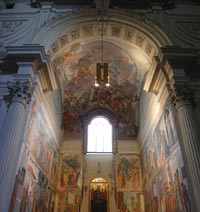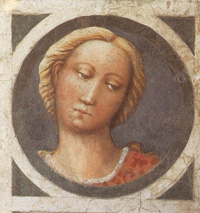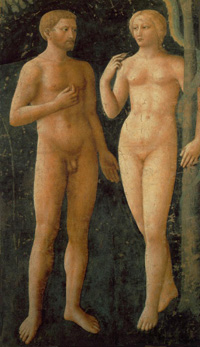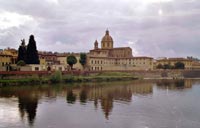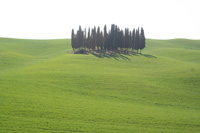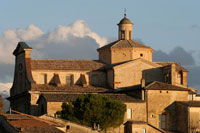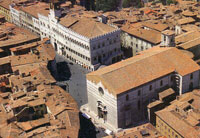 |
|
| I T | Masolino da Panicale, The Temptation, 1426-27, fresco, 208 x 88 cm, Cappella Brancacci, Santa Maria del Carmine, Florence |
Masolino da Panicale (b. 1383, Panicale, d. 1447, Firenze) |
| Masolino da Panicale is generally considered to be a member of the Florentine School, but he travelled a good deal and even went to Hungary. His career is closely linked to that of Masaccio, but the exact nature of the association remains ill-defined. The tradition that he was Masaccio's master is now dismissed, for he became a guild member in Florence only in 1423 (a year after Masaccio) and although he was appreciably the older man it was he who was influenced by Masaccio rather than the other way round. They are thought to have collaborated on The Madonna and Child with St Anne (Uffizi, Florence, c. 1425), but the major undertaking on which they worked together was the decoration of the Brancacci Chapel of Santa Maria del Carmine in Florence. Masolino's style was softer than Masaccio's and there is a fair measure of agreement about the division of hands. Masolino's contributions, completed between 1424 and 1427, include The Preaching of St. Peter, The Raising of Tabitha, and The Fall of Adam and Eve. After Masaccio's death Masolino reverted to the more decorative style he had practiced earlier in his career. At his best he was a painter of great distinction, his masterpiece perhaps being the fresco of the Baptism of Christ (c. 1435) in the Baptistery at Castiglione d'Olona, near Como, a graceful and lyrical work that is a world away from Masaccio's Baptism of the Neophytes in the Brancacci Chapel. Other important frescoes were done for the Church of San Clemente, Rome; and for the Church of Sant'Agostino, Empoli.
|
The Brancacci Chapel of Santa Maria del Carmine in Florence |
||
The foundation of the church dedicated to Our Lady of Carmel dates from 1268, but its construction was protracted until the end of the 15th century.
|
||
| The Brancacci Chapel has one of the supreme masterpieces of renaissance painting: the fresco cycle of Scenes from the life of St Peter, mostly painted in collaboration by Masaccio and Masolino between 1425 and 1427. The frescoes in the upper register are: Adam and Eve in the Earthly Paradise, and Original Sin by Masolino, and the Expulsion of Adam and Eve from the Earthly Paradise with the Tribute Money and the Baptism of the neophytes by Masaccio; also by Masolino are the Preaching of St Peter with the Healing of the lame man and the raising of Tabitha. In the lower register, Masaccio painted the two scenes on the end wall, St Peter curing the sick with his shadow and the Distribution of goods, with the death ot Ananias. The work was left unfinished by Masolino, who took off for Hungary, and by Masaccio, who decamped to Rome (where he died in 1428). Between 1435 and 1458, when the patron Felice Brancacci fell into political disgrace, the friars changed the dedication of the Brancacci Chapel to that of ‘La Madonna del Popolo’, moving the celebrated 13th-century Madonna and Child from the high altar into the chapel. It was perhaps on this occasion that part of Masaccio’s fresco with portraits of the Brancacci patrons was destroyed, a kind of damnatio memoriae. The chapel’s decoration was completed by Filippino Lippi, who between 1481 and 1485 worked on the lower register of the left wall, finishing the Raising of the son of Theophilus and St Peter enthroned which Masaccio had begun, and painting on his own St Peter in prison visited by St Paul on the adjacent pilaster. On the opposite wall he frescoed the Disputation of St Peter and St Paul with Simon Magus, and the Crucifixion of St Peter, and on the pilaster St Peter visited in prison. Between 1746 and 1748 the chapel was extensively redecorated: Vincenzo Meucci frescoed the ceiling with the Virgin consigning the Scapular to St Simon Stock, thus destroying Masolino’s Evangelists. At the same time the lunettes of the Shipwreck of the Apostles and the Calling of the Apostles were painted over.[1] |
||
The 12 frescoes were painted in two rows, six above and six below, that run around three walls of the chapel. The top row starts and ends at the beginning - in Eden - with one of the most famous events in the broad sweep of Judeo-Christian doctrine: on the right, Masolino depicts Adam and Eve at the moment just before the Temptation and the Fall (right). Balancing that view on the left side is Masaccio's interpretation of the expulsion from the Garden. |
||
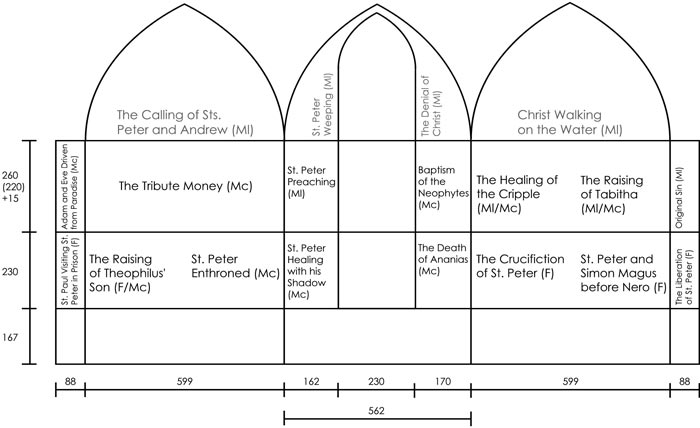 |
||
|
||
The fresco cycle, with the exception of the first two, tells the story of St Peter, as follows:
|
||
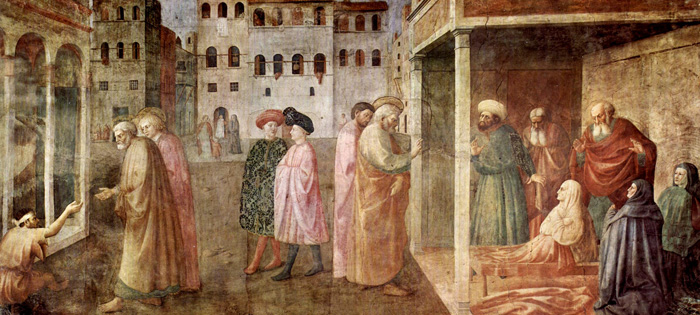 |
||
Healing of the Cripple and Raising of Tabatha ((left view), 1426-27, fresco, Cappella Brancacci, Santa Maria del Carmine, Florence |
||
| The fresco is part of the cycle depicting the story of the life of St Peter. Both events depicted in this fresco are recounted in the Acts of the Apostles: the healing of the cripple in Jerusalem and the raising of Tabitha in Joppa. Masolino sets both events in the same town, although they had actually taken place in different cities and at different times.
This detail shows two elegantly dressed characters, in the centre of the scene, who separate but also provide the link between the two miraculous events. The presence of these figures makes the two events look like normal everyday occurences in the life of a city. |
||
|
||
|
||
|
||
| [1] Brancacci Chapel | www.museumsinflorence.com The church of Santa Maria del Carmine, with the Carmelite monastery, was founded in 1268. The monastery was enlarged in different periodes: a first time in 1328, when the commune permitted to the Carmelites to build on the ground near the fifth city walls; a second time in 1464, when refectory and chapter hall were added; at the end of the enlargment in 17th Century, the monastery included two cloisters, an inner one (built short after the foundation and restored in 1490) and an outer one (built between 1600 and 1612 following the original style of the church). The church was almost completely destroyed in 1771, by the fire arosen during the construction of a new wooden ceiling; the Corsini and Brancacci Chapels, fortunately, were not destroyed, but the rest of the building went completely lost. Next to Santa Maria del Carmine stands the convent, rich in works of art. In the Room of the Column, looking onto the cloister, are displayed fragments of frescoes attributed to Pietro Nelli (c. 1385), other fragments from the Del Pugliese Chapel by Starnina (c. 1404), and a detached fresco of the Confirmation of the Rule by Filippo Lippi (1432). In the old refectory there is a Last Supper by Alessandro Allori (1582); in the second refectory there is the Supper in the house of Simon the Pharisee by Giovan Battista Vanni (c. 1645), and detached frescoes from the Nerli Chapel of Scenes from the Passion of Christ attributed to Lippo d’Andrea (1402). |
||||
Art in Tuscany | Art in Tuscany | Giorgio Vasari | Lives of the Most Excellent Painters, Sculptors, and Architects |
||||
|
This page uses material from the Wikipedia articles Masolino da Panicale and Brancacci Chapel, published under the GNU Free Documentation License. |
||||
Nestled in southern Tuscany and Lazio, the Maremma is one of the most picturesque areas central Italy has to offer. Beautiful medieval hilltop towns with wonderful architecture and history to match await you. Just some of the towns in the area which are worth a stroll around and more include Arcidosso, Castel del Piano, Roccalbegna, Semproniano, Montemerano, Scansano and the spa town of Saturnia. To the north, he towns of Montalcino, Pienza and Montepulciano are all important provincial capitals in the area and within easy driving distance. The walled medieval town of Pienza, by common consent one of Tuscany's most beautiful, is just one hour away and has a small but select group of bars, restaurants and shops. Pienza has some wonderful views over the valley below, so be sure to climb up from the Porta Romana to the via Santa Caterina at the edge of the town and marvel at the wonderful panorama. Holiday houses in Tuscany | Residency in Toscany for writers and artists | Podere Santa Pia |
||||
Podere Santa Pia |
Podere Santa Pia, giardino |
Cypress trees between San Quirico d'Orcia and Montalcino, one of the bird trapping techniques to capture wild birds. |
||
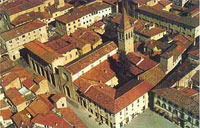 |
||||
Montefalco |
Santa Maria del Carmine, Firenze |
Sansepolcro |
||
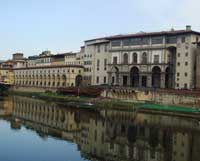 |
||||
Vasari Corridor, Florence |
Perugia |
Florence, Duomo |
||
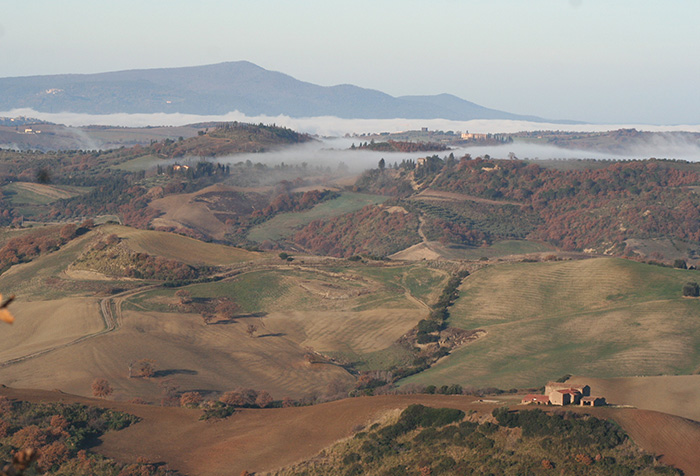 |
||||
Podere Santa Pia, morning view on the Maremma from the northern terrace |
||||
| Santa Maria del Carmine, Florence |
||||
Santa Maria del Carmine is a church of the Carmelite Order, in the Oltrarno district of Florence, in Tuscany, Italy. It is famous as the location of the Brancacci Chapel housing outstanding Renaissance frescoes by Masaccio and Masolino da Panicale, later finished by Filippino Lippi. The second refectory is decorated with the Supper in Simon the Pharisee's house by Giovanni Battista Vanni (c. 1645); it also houses fragments of frescoes by Lippo d'Andrea. |
|
|||

